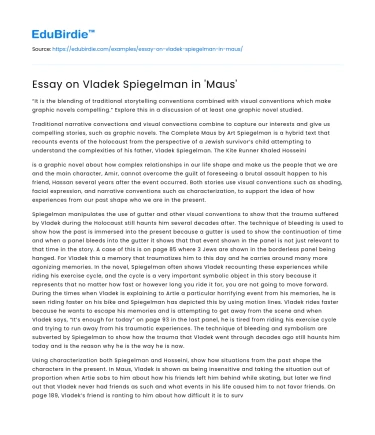“It is the blending of traditional storytelling conventions combined with visual conventions which make graphic novels compelling.” Explore this in a discussion of at least one graphic novel studied.
Traditional narrative convections and visual convections combine to capture our interests and give us compelling stories, such as graphic novels. The Complete Maus by Art Spiegelman is a hybrid text that recounts events of the holocaust from the perspective of a Jewish survivor’s child attempting to understand the complexities of his father, Vladek Spiegelman. The Kite Runner Khaled Hosseini
Save your time!
We can take care of your essay
- Proper editing and formatting
- Free revision, title page, and bibliography
- Flexible prices and money-back guarantee
is a graphic novel about how complex relationships in our life shape and make us the people that we are and the main character, Amir, cannot overcome the guilt of foreseeing a brutal assault happen to his friend, Hassan several years after the event occurred. Both stories use visual conventions such as shading, facial expression, and narrative conventions such as characterization, to support the idea of how experiences from our past shape who we are in the present.
Spiegelman manipulates the use of gutter and other visual conventions to show that the trauma suffered by Vladek during the Holocaust still haunts him several decades after. The technique of bleeding is used to show how the past is immersed into the present because a gutter is used to show the continuation of time and when a panel bleeds into the gutter it shows that that event shown in the panel is not just relevant to that time in the story. A case of this is on page 85 where 3 Jews are shown in the borderless panel being hanged. For Vladek this a memory that traumatizes him to this day and he carries around many more agonizing memories. In the novel, Spiegelman often shows Vladek recounting these experiences while riding his exercise cycle, and the cycle is a very important symbolic object in this story because it represents that no matter how fast or however long you ride it for, you are not going to move forward. During the times when Vladek is explaining to Artie a particular horrifying event from his memories, he is seen riding faster on his bike and Spiegelman has depicted this by using motion lines. Vladek rides faster because he wants to escape his memories and is attempting to get away from the scene and when Vladek says, “It’s enough for today” on page 93 in the last panel, he is tired from riding his exercise cycle and trying to run away from his traumatic experiences. The technique of bleeding and symbolism are subverted by Spiegelman to show how the trauma that Vladek went through decades ago still haunts him today and is the reason why he is the way he is now.
Using characterization both Spiegelman and Hosseini, show how situations from the past shape the characters in the present. In Maus, Vladek is shown as being insensitive and taking the situation out of proportion when Artie sobs to him about how his friends left him behind while skating, but later we find out that Vladek never had friends as such and what events in his life caused him to not favor friends. On page 189, Vladek’s friend is ranting to him about how difficult it is to survive in the concentration camp and how no one will do anything for one another if it doesn’t bring benefits to themselves. “We were all on our own.” Being in a situation where you have no one to turn to shapes you into having a selfish mindset. Similarly in The Kite Runner, Amir is witness to brutal sexual assault that occurred to his friend Hassan, and in the short term that caused Amir to distance himself from Hassan till he moved town, and in the long term, carrying this guilt of not stopping the assault, Amir is reluctant on finding Hassan’s son and bringing him under the care of a family friend after finding that Hassan has died. The reason for this reluctance is that Amir doesn’t want to face his guilt and this is shown by his facial expressions which show several stress lines and his rage expressed in his outlandish movement and words, “This is impossible… I don’t want to hear anymore.” Amir is at first in denial of the idea of having Hassan’s son as his nephew but after some time thinking and reconciliating with himself, he decides to help as a way to bring peace to himself. Both characters face different situations but both have faced an event in their past that shapes how they react and handle situations in the present.






 Stuck on your essay?
Stuck on your essay?

